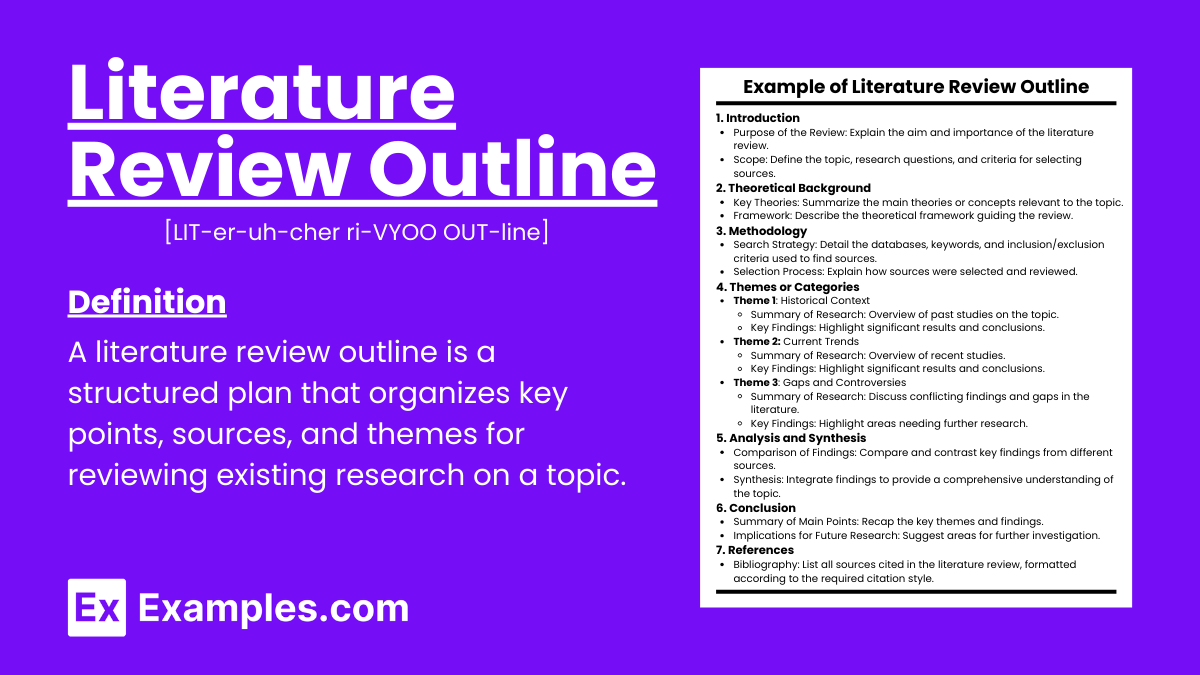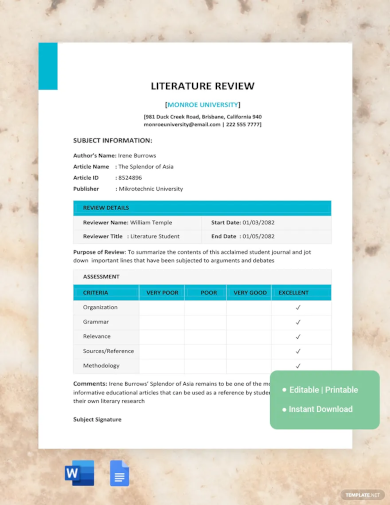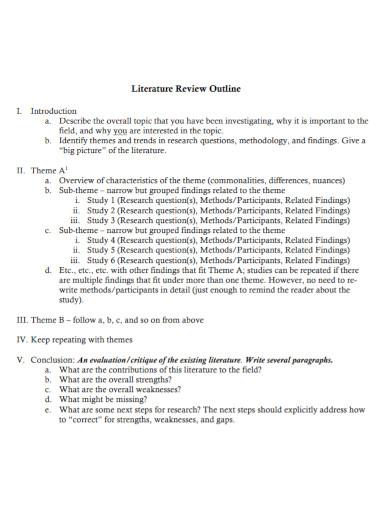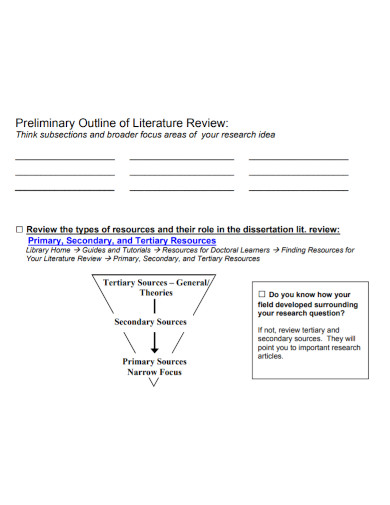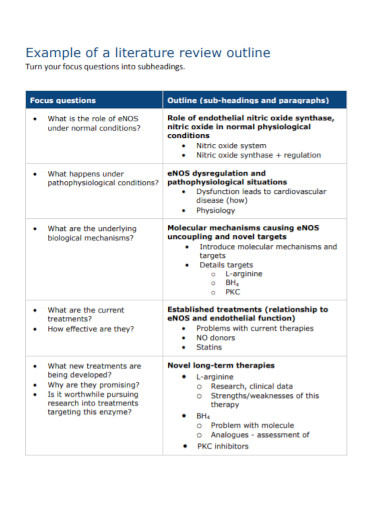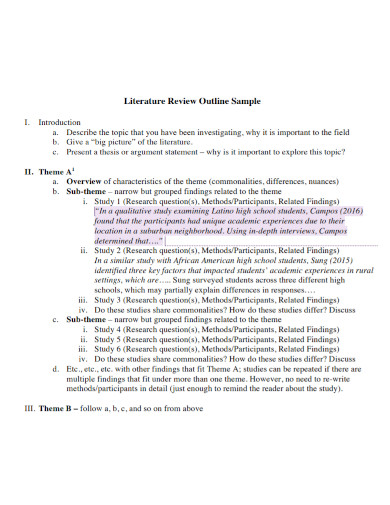10+ Literature Review Outline Examples to Download
Literature Review. We all been there, especially those who are currently in high school or college. We get to review different types of literary pieces ranging from short stories, poem, and novels just to name a few. It can be confusing when you have a lot of ideas but you have no idea how to formulate them into one clean thought. It can also be quite frustrating if you have to start from the beginning or back to square one if you forgot a single part of the whole, but don’t worry, here are some literature review outline examples you can download to help you with your problems. Let’s check them out.
What is a Literature Review Outline?
A literature review outline is a structured framework that organizes and summarizes existing research on a specific topic. It helps identify key themes, gaps, and methodologies in the literature. The outline typically includes sections such as introduction, major themes, sub-themes, methodologies, and conclusions, facilitating a clear and comprehensive review of the literature.
Literature Review Format
A literature review is a comprehensive summary of previous research on a topic. It includes a systematic examination of scholarly article, book, and other sources relevant to the research area. Here’s a guide to structuring a literature review effectively:
Introduction
- Purpose and Scope
- Explain the purpose of the literature review.
- Define the scope of the review – what is included and what is excluded.
- State the research question or objective.
- Background Information
- Provide context or background information necessary to understand the literature review.
- Highlight the significance of the topic.
Body
- Thematic Organization
- Organize the literature review by themes, trends, or methodological approaches rather than by individual sources.
- Use headings and subheadings to categorize different themes or topics.
- Summary of Sources
- For each theme or section, summarize the key findings of the relevant literature.
- Highlight major theories, methodologies, and conclusions.
- Note any significant debates or controversies.
- Critical Analysis
- Critically evaluate the sources.
- Discuss the strengths and weaknesses of the existing research.
- Identify gaps or inconsistencies in the literature.
- Comparison and Synthesis
- Compare and contrast different sources.
- Synthesize the information to provide a coherent narrative.
- Show how the different studies are related to one another.
Conclusion
- Summary of Key Findings
- Summarize the main findings from the literature review.
- Highlight the most important insights and their implications.
- Research Gaps
- Identify any gaps in the existing research that require further investigation.
- Suggest areas for future research.
- Overall Significance
- Discuss the overall significance of the literature review.
- Explain how it contributes to the field of study and the specific research question.
References
- List all the sources cited in the literature review.
- Follow the appropriate citation style (APA, MLA, Chicago, etc.) as required by your academic institution.
Research Literature Review Outline Example
I. Introduction
Background Information:
- Provide context and background on the research topic.
- Explain the importance of the topic in the current research landscape.
Purpose of the Review:
- State the main objectives of the literature review.
- Clarify the research questions or hypotheses guiding the review.
Scope of the Review:
- Define the scope, including time frame, types of studies, and key themes.
- Explain any limitations or boundaries set for the review.
II. Search Strategy
Databases and Sources:
- List the databases and other sources used to find relevant literature.
Keywords and Search Terms:
- Detail the specific keywords and search terms employed.
Inclusion and Exclusion Criteria:
- Describe the criteria for including or excluding studies.
III. Theoretical Framework
Relevant Theories:
- Introduce and explain the key theories and models related to the research topic.
Application of Theories:
- Discuss how these theories provide a foundation for understanding the literature.
IV. Review of Literature
Thematic Organization:
- Organize the literature into themes or categories based on common findings or approaches.
Example Structure:
Theme 1: Impact of Rising Temperatures
- Summarize key studies and findings.
- Compare and contrast different research approaches.
Theme 2: Changing Precipitation Patterns
- Highlight significant studies and their results.
- Discuss any conflicting findings or perspectives.
Theme 3: Socioeconomic Factors
- Review literature focusing on socioeconomic impacts.
- Analyze how these factors interact with environmental changes.
V. Critical Analysis
Strengths and Weaknesses:
- Evaluate the strengths and limitations of the reviewed studies.
- Discuss the reliability and validity of the methodologies used.
Methodological Critique:
- Assess the methodologies for potential biases and gaps.
VI. Discussion and Synthesis
Integration of Findings:
- Synthesize the findings from the literature into a cohesive narrative.
- Highlight common themes, trends, and gaps.
Research Gaps:
- Identify areas where further research is needed.
- Suggest potential future research directions.
VII. Conclusion
Summary of Main Findings:
- Summarize the key insights and conclusions drawn from the literature review.
Importance of the Topic:
- Reiterate the significance of the research topic.
Implications for Future Research:
- Outline the implications of the findings for future research.
VIII. References
- Citation List:
- Provide a complete list of all sources cited in the literature review.
- Follow a specific citation style (e.g., APA, MLA, Chicago).
IX. Appendices (if applicable)
- Supplementary Material:
- Include tables, charts, or detailed methodological information that supports the review but is too extensive for the main text.
Thematic Literature Review Outline Example
I. Introduction
Background Information:
- Provide context and background on the research topic.
- Explain the importance of the topic in the current research landscape.
Purpose of the Review:
- State the main objectives of the literature review.
- Clarify the research questions or hypotheses guiding the review.
Scope of the Review:
- Define the scope, including time frame, types of studies, and key themes.
- Explain any limitations or boundaries set for the review.
II. Search Strategy
Databases and Sources:
- List the databases and other sources used to find relevant literature.
Keywords and Search Terms:
- Detail the specific keywords and search terms employed.
Inclusion and Exclusion Criteria:
- Describe the criteria for including or excluding studies.
III. Thematic Review of Literature
Theme 1: Impact of Rising Temperatures
- Summary of Key Studies:
- Summarize the findings of major studies related to rising temperatures.
- Example: “Smith et al. (2020) found that increasing temperatures have led to a 5% decline in crop yields globally.”
- Comparison of Research Approaches:
- Compare different methodologies and approaches used in the studies.
- Example: “While Jones (2018) used a longitudinal study, Brown (2019) employed a cross-sectional analysis.”
Theme 2: Changing Precipitation Patterns
- Summary of Key Studies:
- Highlight significant studies and their results.
- Example: “Lee and Wang (2021) reported that altered precipitation patterns have increased the frequency of droughts.”
- Discussion of Conflicting Findings:
- Discuss any contradictory findings or differing perspectives.
- Example: “Contrary to Lee and Wang, Garcia (2020) found minimal impact of precipitation changes on crop health.”
Theme 3: Socioeconomic Factors
- Summary of Key Studies:
- Review literature focusing on the socioeconomic impacts of climate change.
- Example: “Davis (2017) highlighted the disproportionate effects on small-scale farmers.”
- Analysis of Interactions:
- Analyze how socioeconomic factors interact with environmental changes.
- Example: “Economic instability exacerbates the vulnerability to climate impacts (Green, 2018).”
IV. Critical Analysis
Strengths and Weaknesses:
- Evaluate the strengths and limitations of the reviewed studies.
- Example: “Many studies provide robust data but often lack consideration of regional variability.”
Methodological Critique:
- Assess the methodologies for potential biases and gaps.
- Example: “There is a notable reliance on regional data, limiting the generalizability of findings.”
V. Discussion and Synthesis
Integration of Findings:
- Synthesize the findings from the literature into a cohesive narrative.
- Example: “The review indicates a clear trend of climate change negatively impacting agriculture, though the extent varies regionally.”
Identification of Gaps:
- Identify areas where further research is needed.
- Example: “There is a gap in research on adaptive farming practices and their effectiveness.”
VI. Conclusion
Summary of Main Findings:
- Summarize the key insights and conclusions drawn from the literature review.
- Example: “Overall, rising temperatures and changing precipitation patterns are significantly affecting agricultural productivity.”
Importance of the Topic:
- Reiterate the significance of the research topic.
- Example: “Understanding these impacts is crucial for developing effective adaptation strategies.”
Implications for Future Research:
- Outline the implications of the findings for future research.
- Example: “Future research should focus on adaptive measures to mitigate the adverse effects on agriculture.”
VII. References
- Citation List:
- Provide a complete list of all sources cited in the literature review.
- Example:
- Smith, J. et al. (2020). Impact of Rising Temperatures on Global Crop Yields. Journal of Environmental Studies, 45(3), 234-250.
- Lee, S. & Wang, H. (2021). Precipitation Patterns and Drought Frequency. Climate Research Journal, 29(2), 98-115.
VIII. Appendices (if applicable)
- Supplementary Material:
- Include tables, charts, or detailed methodological information that supports the review but is too extensive for the main text.
- Example: “Appendix A includes a table of regional crop yield changes from 2000 to 2020.”
Literature Review Outline Example in APA Format
1. Title Page
- Title of the Review
- Author’s Name
- Institutional Affiliation
- Course Name and Number
- Instructor’s Name
- Due Date
2. Abstract
- Summary of the Literature Review
- Brief overview of the main points
- Research question or thesis
- Key findings
- Implications
3. Introduction
- Introduction to the Topic
- General introduction to the subject area
- Importance of the topic
- Purpose of the Review
- Specific objectives of the literature review
- Research Questions or Hypotheses
- Main research question(s) or hypotheses guiding the review
- Organization of the Review
- Brief outline of the structure of the literature review
4. Theoretical Framework
- Relevant Theories and Models
- Description of key theories and models relevant to the topic
- Application of Theories
- Explanation of how these theories are applied to the research problem
5. Review of the Literature
- Historical Context
- Background and historical development of the research topic
- Current Research
- Summary of recent studies and their findings
- Methodologies Used
- Overview of research methods used in the studies
- Themes and Patterns
- Common themes and patterns identified in the literature
- Contradictions and Gaps
- Conflicting findings and gaps in the literature
6. Critical Analysis
- Evaluation of Key Studies
- Critical analysis of the most influential studies
- Strengths and limitations of these studies
- Comparison of Different Approaches
- Comparative analysis of different perspectives and methodologies
7. Synthesis of Findings
- Integration of Theories and Results
- How the findings integrate with the theoretical framework
- Overall Trends
- Summary of the major trends in the literature
- Gaps in the Research
- Identification of gaps and areas for further research
8. Conclusion
- Summary of Main Findings
- Recap of the most significant findings from the review
- Implications for Future Research
- Suggestions for future research directions
- Practical Applications
- Implications for practice or policy
9. References
- Complete Citation of Sources
- Proper APA format for all sources cited in the literature review
10. Appendices (if necessary)
- Additional Material
- Any supplementary material such as tables, figures, or questionnaires
Literature Review Outline Templates & Samples in PDF
1. Literature Review Template
3. Literature Review Outline Template
6. Preliminary Outline of Literature Review
7. Literature Review Outline Example
8. Printable Literature Review Outline
Types of Literature Review
A literature review is an essential part of academic research, providing a comprehensive summary of previous studies on a particular topic. There are various types of literature reviews, each serving a different purpose and following a unique structure. Here, we explore the main types:
1. Narrative Review
A narrative review, also known as a traditional or descriptive review, provides a comprehensive synthesis of the existing literature on a specific topic. It focuses on summarizing and interpreting the findings rather than conducting a systematic analysis.
2. Systematic Review
A systematic review follows a rigorous and predefined methodology to collect, analyze, and synthesize all relevant studies on a particular research question. It aims to minimize bias and provide reliable findings.
3. Meta-Analysis
A meta-analysis is a subset of systematic reviews that statistically combines the results of multiple studies to arrive at a single conclusion. It provides a higher level of evidence by increasing the sample size and improving the precision of the results.
4. Scoping Review
A scoping review aims to map the existing literature on a broad topic, identify key concepts, theories, and sources, and clarify research gaps. It is often used to determine the scope of future research.
5. Critical Review
A critical review evaluates the quality and validity of the existing literature, often questioning the methodology and findings. It provides a critical assessment and aims to present a deeper understanding of the topic.
6. Theoretical Review
A theoretical review focuses on analyzing and synthesizing theories related to a specific topic. It aims to understand how theories have evolved over time and how they can be applied to current research.
7. Integrative Review
An integrative review synthesizes research on a topic in a more holistic manner, combining perspectives from both qualitative and quantitative studies. It aims to generate new frameworks and perspectives.
8. Annotated Bibliography
An annotated bibliography provides a summary and evaluation of each source in a list of references. It includes a brief description of the content, relevance, and quality of each source.
9. Rapid Review
A rapid review streamlines the systematic review process to provide evidence in a timely manner. It is often used in healthcare and policy-making to inform decisions quickly.
10. Umbrella Review
An umbrella review, or overview of reviews, synthesizes the findings of multiple systematic reviews on a particular topic. It provides a high-level summary and identifies broader patterns and trends.
Purpose of a Literature Review
A literature review is a critical component of academic research, serving multiple important purposes. It provides a comprehensive overview of existing knowledge on a topic, helps identify research gaps, and sets the context for new research. Here are the key purposes of a literature review:
1. Summarizing Existing Research
A literature review summarizes and synthesizes the findings of previous studies related to a specific topic. This helps researchers understand what is already known and what remains to be explored.
2. Identifying Research Gaps
By reviewing existing literature, researchers can identify gaps or inconsistencies in the current knowledge. This allows them to pinpoint areas where further investigation is needed and justify the need for their research.
3. Providing Context and Background
A literature review sets the context for new research by providing background information. It helps readers understand the broader landscape of the topic and how the current study fits into it.
4. Establishing the Theoretical Framework
Literature reviews often involve discussing various theories and models relevant to the topic. This helps establish a theoretical framework for the research, guiding the study’s design and methodology.
5. Demonstrating Researcher Knowledge
Conducting a thorough literature review demonstrates that the researcher is knowledgeable about the field. It shows that they are aware of the key studies, debates, and trends in their area of research.
6. Justifying Research Questions and Methodology
A literature review helps justify the research questions and methodology of a study. By showing how previous studies were conducted and what their limitations were, researchers can argue for their chosen approach.
7. Avoiding Duplication
Reviewing existing literature ensures that researchers do not duplicate previous studies unnecessarily. It helps them build on existing work rather than repeating it.
8. Highlighting Key Findings and Trends
A literature review highlights significant findings and trends in the research area. This helps researchers understand the development of the field and identify influential studies and seminal works.
9. Informing Practice and Policy
In applied fields, literature reviews can inform practice and policy by summarizing evidence on what works and what doesn’t. This helps practitioners and policymakers make evidence-based decisions.
10. Facilitating a Comprehensive Understanding
Overall, a literature review facilitates a comprehensive understanding of the topic. It integrates various perspectives, findings, and approaches, providing a well-rounded view of the research area.
Components of a Literature Review
A well-structured literature review is essential for providing a clear and comprehensive overview of existing research on a particular topic. The following components are typically included in a literature review:
1. Introduction
The introduction sets the stage for the literature review. It provides background information on the topic, explains the review’s purpose, and outlines its scope.
Example: “Over the past decade, research on climate change’s impact on agriculture has proliferated. This literature review aims to synthesize these studies, focusing on the effects of rising temperatures and changing precipitation patterns on crop yields.”
2. Search Strategy
The search strategy describes how the literature was identified. This includes the databases and search engines used, search terms and keywords, and any inclusion or exclusion criteria.
Example: “The literature search was conducted using databases such as PubMed, Google Scholar, and JSTOR. Keywords included ‘climate change,’ ‘agriculture,’ ‘crop yields,’ and ‘precipitation patterns.’ Studies published between 2000 and 2023 were included.”
3. Theoretical Framework
The theoretical framework presents the theories and models relevant to the research topic. This section provides a foundation for understanding the studies reviewed.
Example: “This review utilizes the Sustainable Livelihoods Framework to analyze the impact of climate change on agricultural communities, focusing on how environmental changes affect economic stability and food security.”
4. Review of Literature
The core of the literature review, this section summarizes and synthesizes the findings of the selected studies. It is often organized thematically, chronologically, or methodologically.
Example: “Studies from the early 2000s focused on temperature changes, while recent research has shifted to examining precipitation patterns. Common findings include a general decline in crop yields, with significant regional variations.”
5. Critical Analysis
A critical analysis evaluates the strengths and weaknesses of the existing research. This involves assessing the methodology, data, and conclusions of the studies reviewed.
Example: “Many studies used longitudinal data to track changes over time, but few incorporated socioeconomic factors. Additionally, the reliance on regional data limits the generalizability of some findings.”
6. Discussion and Synthesis
The discussion and synthesis section integrates the findings from the literature review, highlighting common themes, trends, and gaps. It connects the reviewed studies to the current research question.
Example: “The literature consistently shows that rising temperatures negatively affect crop yields. However, there is a gap in understanding the role of adaptive farming practices, suggesting a need for further research in this area.”
7. Conclusion
The conclusion summarizes the main findings of the literature review. It reiterates the importance of the research topic and outlines the implications for future research.
Example: “In summary, climate change poses a significant threat to agricultural productivity. Future research should focus on adaptive strategies to mitigate these effects and ensure food security.”
8. References
The references section lists all the sources cited in the literature review. It should follow a specific citation style, such as APA, MLA, or Chicago.
Example:
- Smith, J. (2021). Climate Change and Crop Yields. Journal of Environmental Science, 12(3), 45-60.
- Brown, A., & Jones, B. (2019). Precipitation Patterns and Agriculture. Climate Research, 8(2), 34-48.
9. Appendices (if applicable)
Appendices may include supplementary material that is relevant to the literature review but would disrupt the flow of the main text. This could include tables, charts, or detailed methodological information.
Example: “Appendix A includes a table of regional crop yield changes from 2000 to 2020. Appendix B provides a detailed description of the data collection methods used in the reviewed studies.”
How to Write a Literature Review
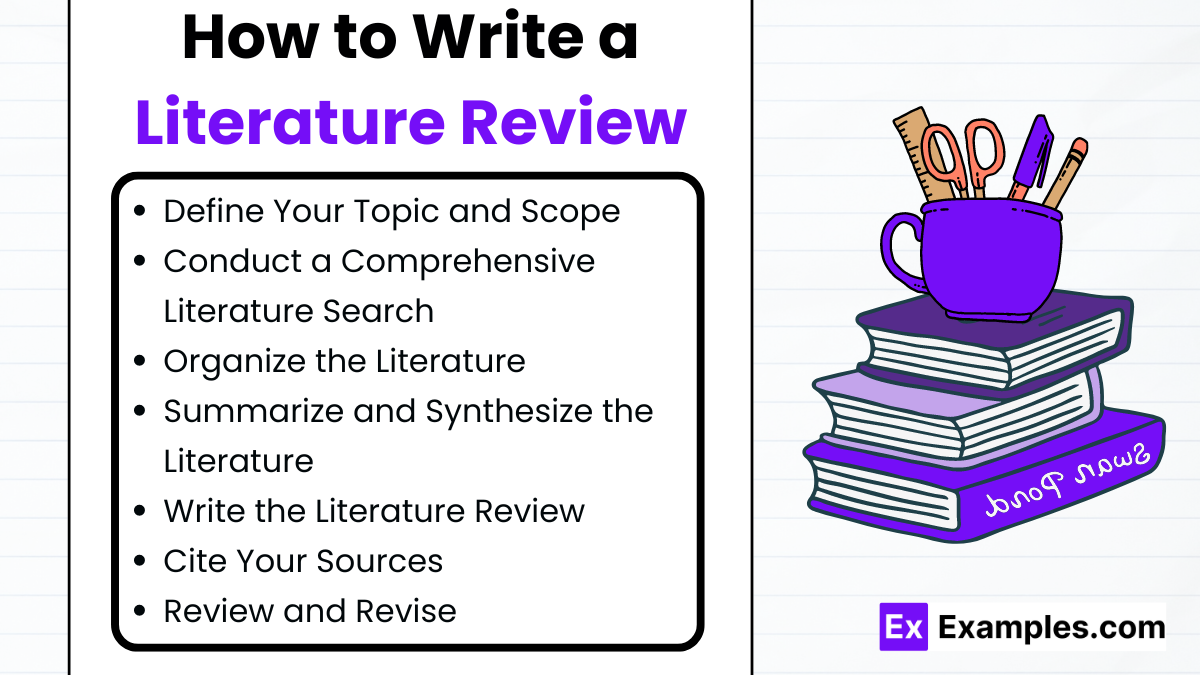
Writing a literature review involves several steps to ensure that you provide a comprehensive, critical, and coherent summary of existing research on a specific topic. Here is a step-by-step guide to help you write an effective literature review:
1. Define Your Topic and Scope
- Identify your research question or thesis.
- Decide on the scope (broad topic or specific aspect, time frame, types of studies).
2. Conduct a Comprehensive Literature Search
- Identify key sources (use academic databases like PubMed, Google Scholar, JSTOR).
- Use relevant keywords to search for literature.
- Select relevant studies by reviewing abstracts.
3. Organize the Literature
- Group studies by themes (methodology, findings, theoretical perspective).
- Create an outline to structure your review.
4. Summarize and Synthesize the Literature
- Summarize key findings for each study.
- Synthesize information by comparing and contrasting studies.
5. Write the Literature Review
- Introduction:
- Introduce the topic.
- Explain the purpose of the review.
- Outline the scope.
- Body:
- Discuss literature thematically or chronologically.
- Present summaries and syntheses.
- Highlight patterns, contradictions, and gaps.
- Critical Analysis:
- Evaluate methodologies and findings.
- Discuss strengths and weaknesses of studies.
- Conclusion:
- Summarize main findings.
- Reiterate the importance of the topic.
- Suggest areas for future research.
6. Cite Your Sources
- Use a consistent citation style (APA, MLA, Chicago).
7. Review and Revise
- Proofread for grammatical errors and clarity.
- Revise for coherence and logical flow.
How do I start a literature review?
Begin by defining your research question and scope, then conduct a comprehensive search for relevant literature using academic databases.
What is the purpose of a theoretical framework?
It provides a foundation for understanding the literature and guides the analysis of existing studies.
How should I organize the literature review?
Organize it thematically, chronologically, or methodologically, depending on what best suits your research question.
How do I choose which studies to include?
Use inclusion and exclusion criteria based on relevance, publication date, and quality of the studies.
What is the difference between a thematic and chronological organization?
Thematic organization groups studies by topics or themes, while chronological organization arranges them by the date of publication.
How do I critically analyze the literature?
Evaluate the strengths and weaknesses of each study, assess methodologies, and discuss biases or gaps.
What should be included in the introduction?
Provide background information, state the purpose of the review, and outline its scope.
How can I synthesize findings from different studies?
Integrate the results to highlight common themes, trends, and gaps, providing a cohesive narrative.
Why are references important in a literature review?
References provide evidence for your review, ensure academic integrity, and allow readers to locate the original sources.
What role do appendices play in a literature review?
Appendices include supplementary material like tables or detailed methodologies that support the review but are too extensive for the main text.



